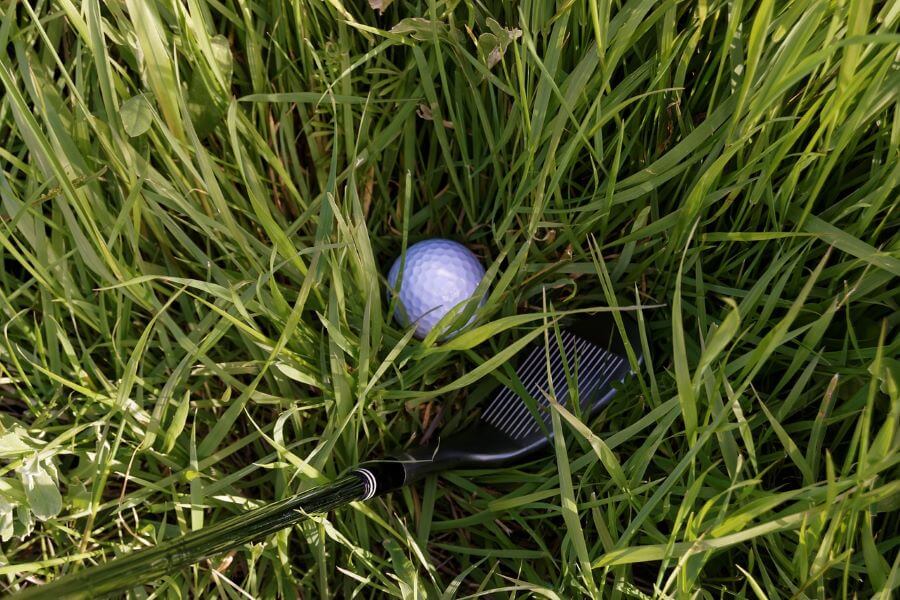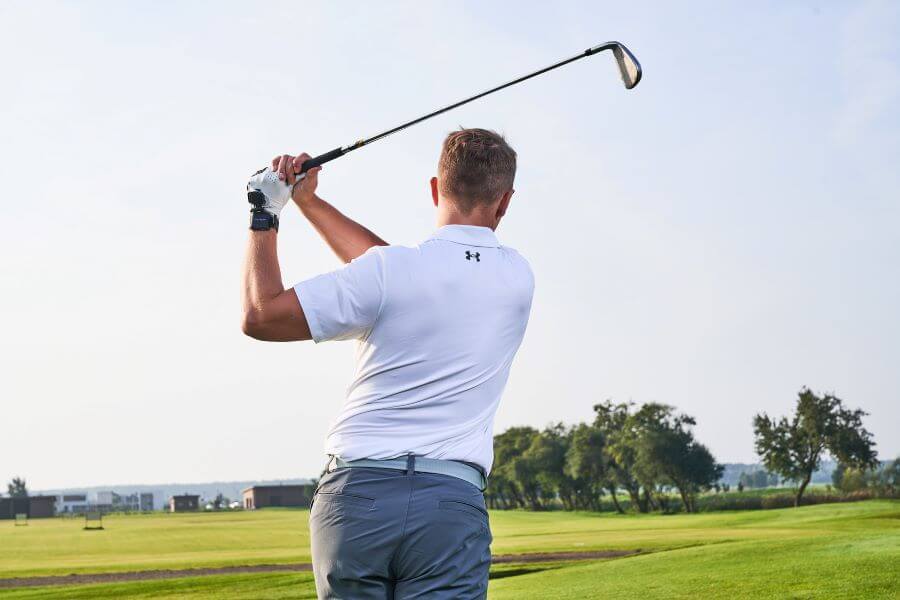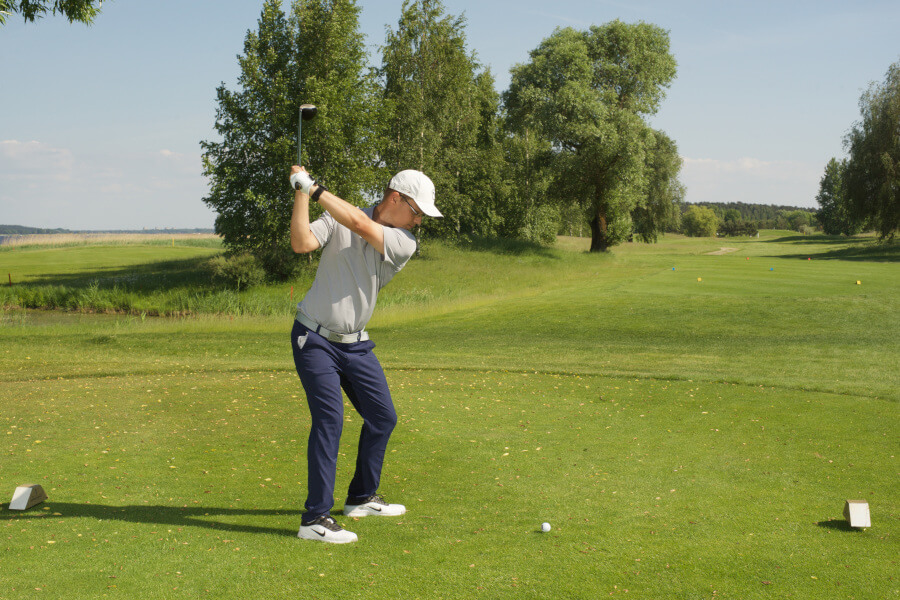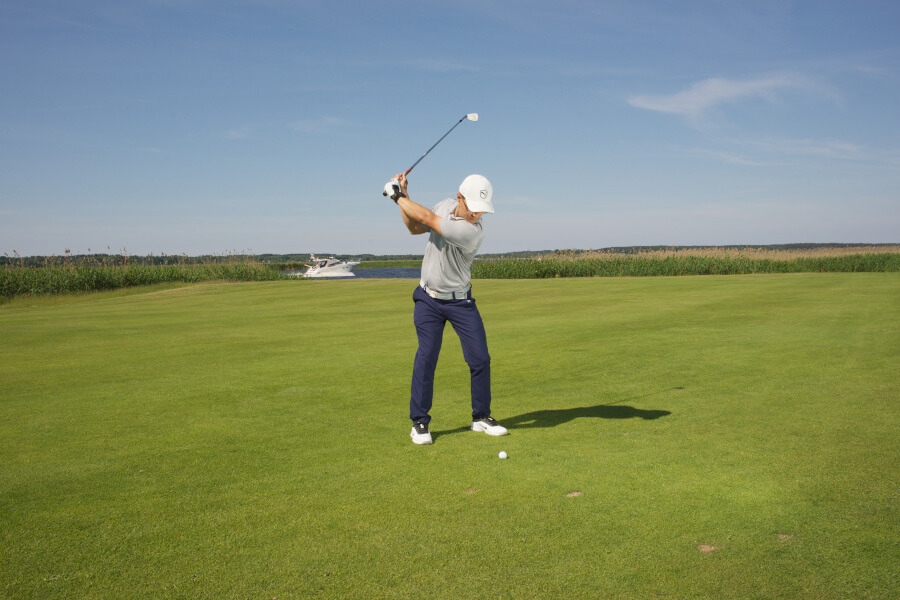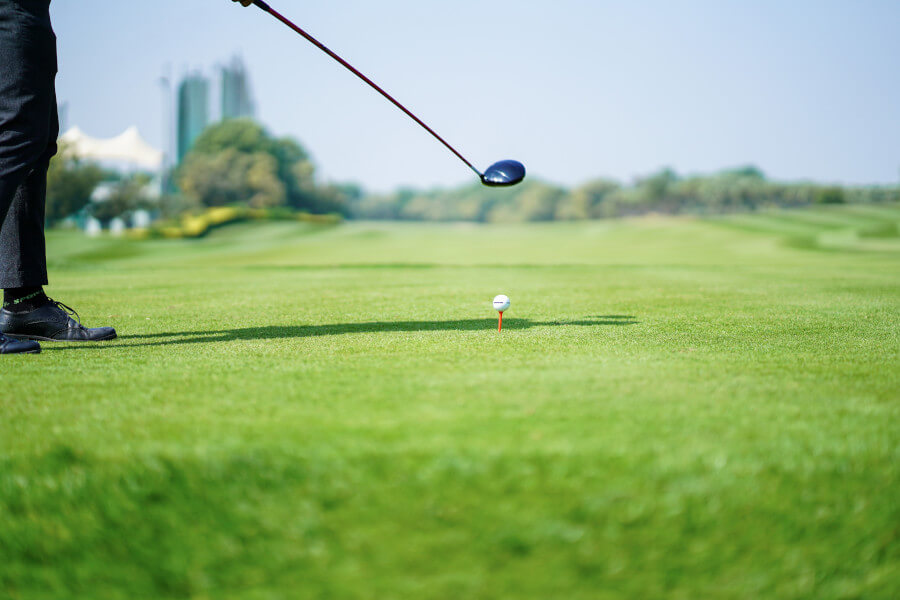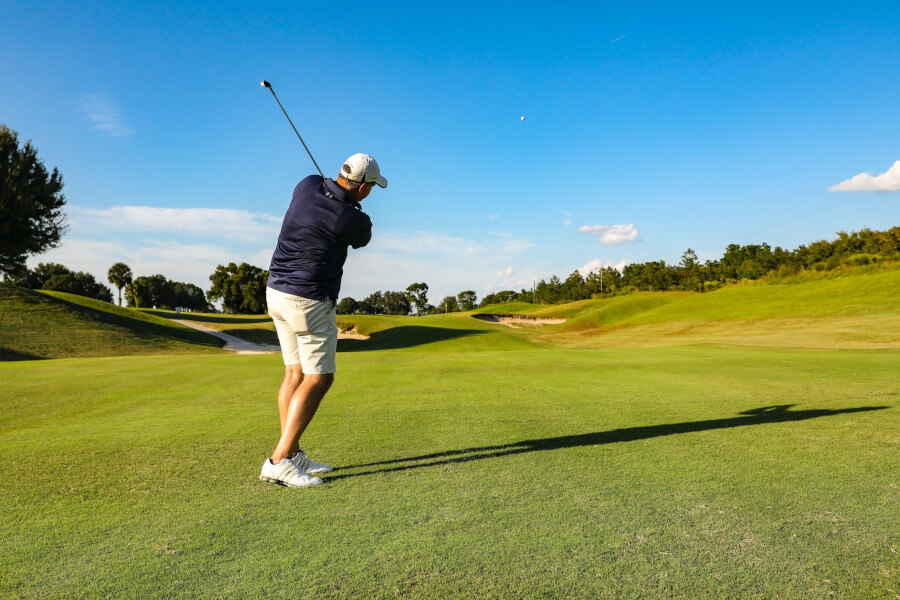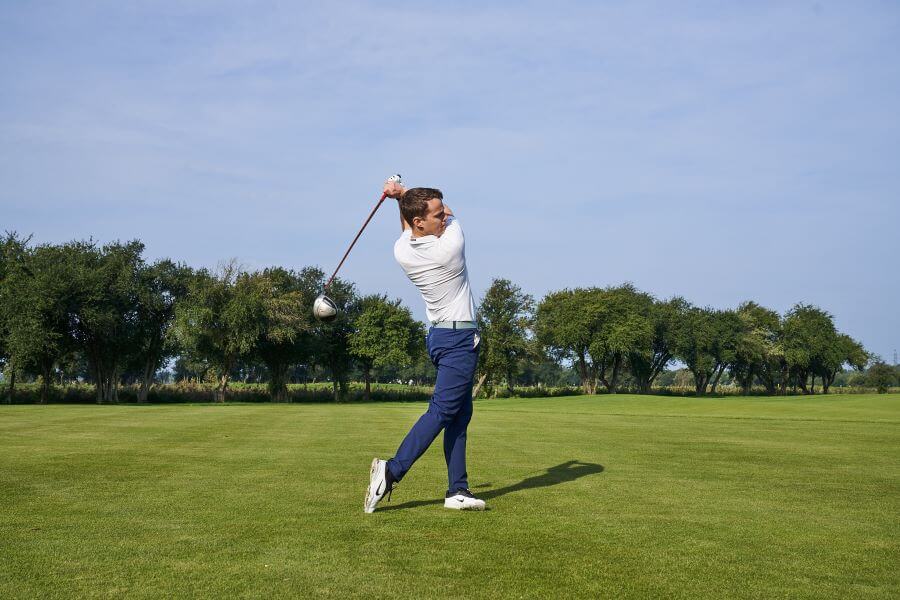How to Hold a Golf Club – The Complete Guide (With Tour Player Data for Comparison)
Although some golfers may say, “Grip it and rip it,” this isn’t giving the grip portion of the game the attention it needs. In fact, many would argue the grip is more important than many other parts of the golf swing.
Why?
The grip is your foundation; if it’s correct, it gets you started on the right track to make a great swing. If it’s incorrect, you will be left with a wide range of issues that can occur.
Before you start worrying about your swing plane and your timing, make sure your grip is correct.
I’ll show you how to hold a golf club, how tour players hold a club, and your options for different types of grips.
How to Hold a Golf Club – Too Long, Didn’t Read
Hold a golf club with the grip sitting mostly in your fingers. The left hand is the lead hand for right-handed players, and it will have the largest role in what the club does. The right hand sits directly below the left hand and also must be in the fingers.
Golf grips can get a bit complicated because there are different methods, and the proper golf grip for my swing may be a bit different than it is for yours.
Here are some key points to keep in mind when working on how to hold a golf club.
- The golf club should always be more in your fingers than in the palm of your hands.
- A correct golf grip can lead to a correct face angle at impact.
- Golfers with poor grip pressure and poor grip position will struggle with consistency in their game.
- Once you find a grip you love, check on it periodically, but keep it in place for years to come.
- Remember that how you hold a golf club can change based on hand size as well as grip size.
Contents
- How to Grip a Golf Club – Step-by-Step Guide to Holding a Golf Club
- Grip Strength Explained
- Grip Pressure Explained
- Proper Golf Grip: How Grip Affects My Shots?
- How does Grip Size Impact Grip Type? (What about Hand Size?)
- How Can I Test the Consistency of My Golf Grip?
- How Tour Players Grip
- FAQs
- Final Thoughts
How to Grip a Golf Club – Step-by-Step Guide to Holding a Golf Club
If you want to understand how foreign or difficult it is to hold a golf club, try teaching this to a 5-year-old. When you tell most 5-year-old kids how to hold a golf club, they say, “But why?”.
What a great question!
Why do we hold the club the way we do? The simple answer is to try and return the clubface to square at impact.
However, we can do that in a few different ways, including the overlap grip, interlock grip, and the 10 finger grip.
Overlap Golf Grip
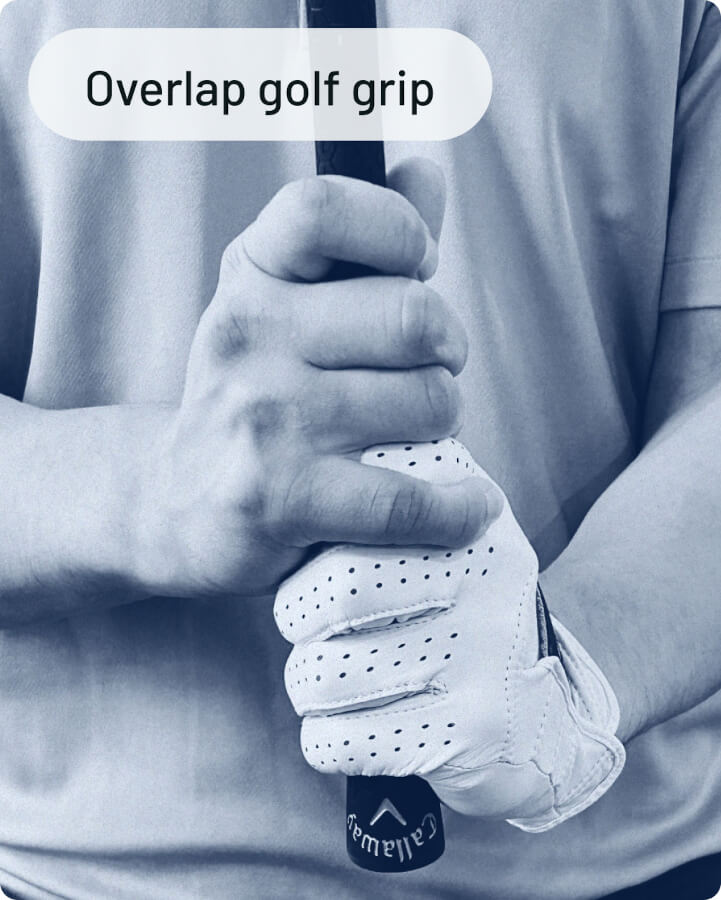
The overlap grip involves connecting the left and right hand on the club by overlapping the left forefinger and the right pinky; here is how to get your hands into an overlapping grip position. (for a right-handed player)
- Start with your left-hand position; place the club across the base of your fingers so that when you wrap them around, the club sits mostly in the fingers and not in the palm of your hand.
- Next, make sure that your thumb is pointed just to the right of center on the club, have it point down the shaft, and do not wrap it around.
- Next, place your right hand directly underneath your left hand, take the pinky on your right hand, and place it between your index and middle finger on the club.
- Essentially your right-hand overlaps the left hand.
- Now close the right hand around the left so that the left thumb fits perfectly in the palm of the right hand.
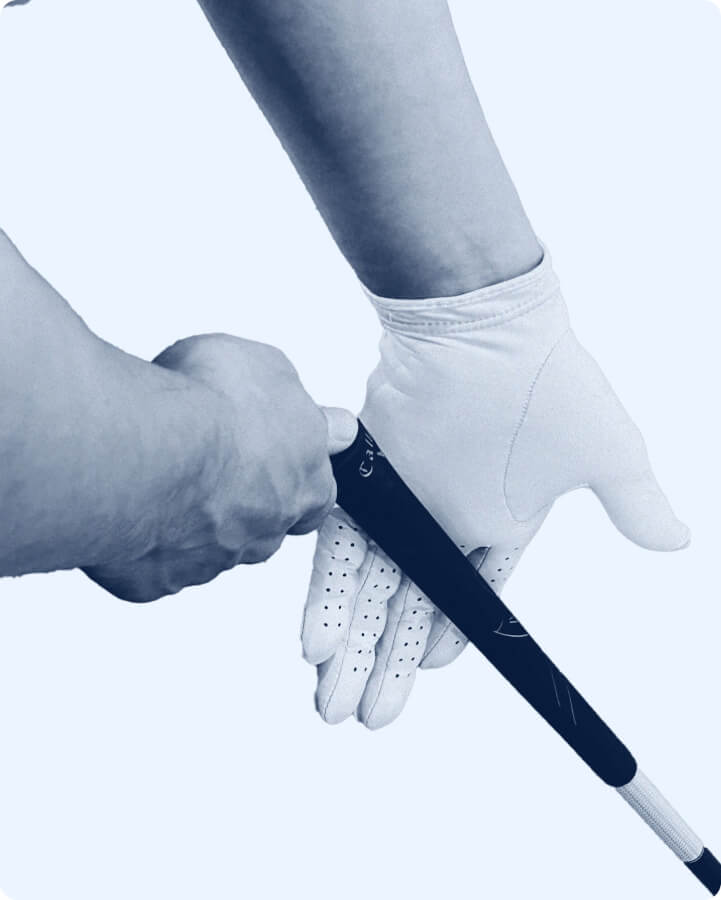
These are the basics of the overlap golf grip, but there are a few things to know and understand.
First, this grip does wonders for your grip pressure. If you tend to grip the golf club too tightly, then you will want to hold a golf club with an overlap grip.
In addition, I like to take my pinky finger and actually rest it on top of my index finger, not between the index and middle. When it’s between the index and middle, I start to grip the club with more tension than necessary.
The overlap grip tends to be a great choice for golfers with larger hands, and many professionals seeking a better feel also gravitate towards the overlap golf grip.
Pros
- Reduces tension in the hands.
- Helps golfers with large hands.
- Increases feel around the greens.
- Feels more natural and incorporates the body more than hands and wrists into the swing.
Cons
- It can be harder to control the club.
- Some golfers with small hands will feel as though they can’t maintain clubface angle.
- Feels very weak initially.
Interlocking Golf Grip
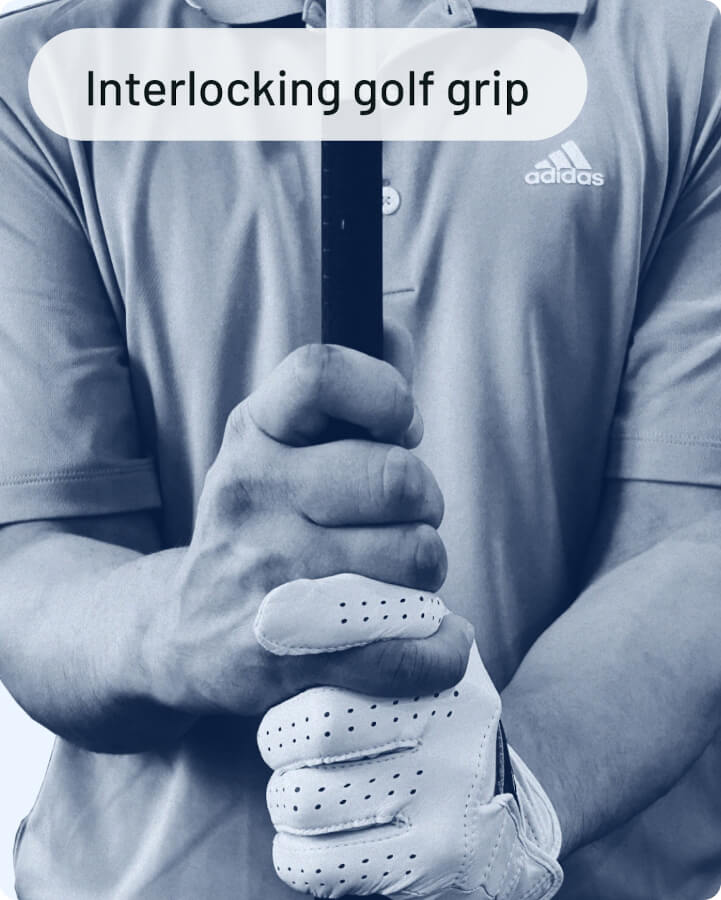
The interlocking grip connects the left and the right hand on the club by interlocking the left index finger with the right pinky.
Interlocking golf grip is very common among golfers and is the preferred grip of Tiger Woods.
- Start with your left hand position; place the club across the base of your fingers so that when you wrap them around, the club sits mostly in the fingers and not in the palm of your hand.
- Next, make sure that your thumb is pointed just to the right of center on the club, have it point down the shaft, and do not wrap it around.
- Next, place your right hand directly underneath your left hand and take the pinky on your right hand and interlock it with the index finger on your right hand.
- When doing this, it will feel as though you now don’t have your pinky on the club; it’s lying on top of your other fingers.
- Now close the right hand around the left so that the left thumb fits perfectly in the palm of the right hand.
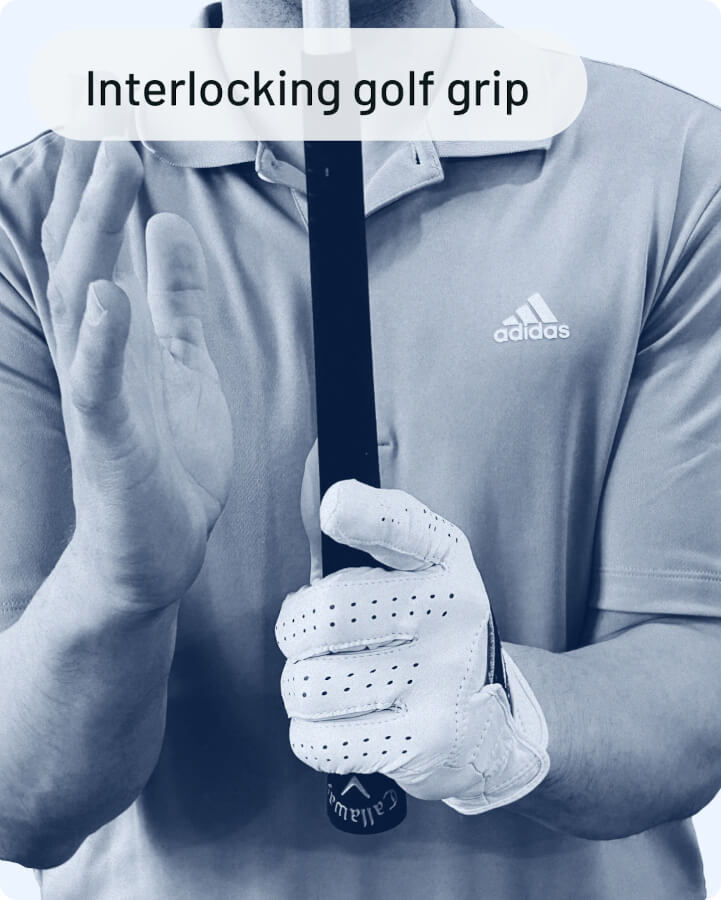
There are some great things about the interlocking grip, the most important of which is power.
You can get a lot of power when you have a firm and stable connection to the club. Golfers trust this interlock, and it takes away fears as your club travels through impact.
In addition, many players find that when learning a golf grip, the interlocking seems to be more natural than the overlap. When you get the hands into the proper position, they feel as though they were made to be positioned like that.
Finally, players with smaller hands tend to enjoy the interlocking grip because it increases the connection strength and makes it easier to wrap your hands around the club.
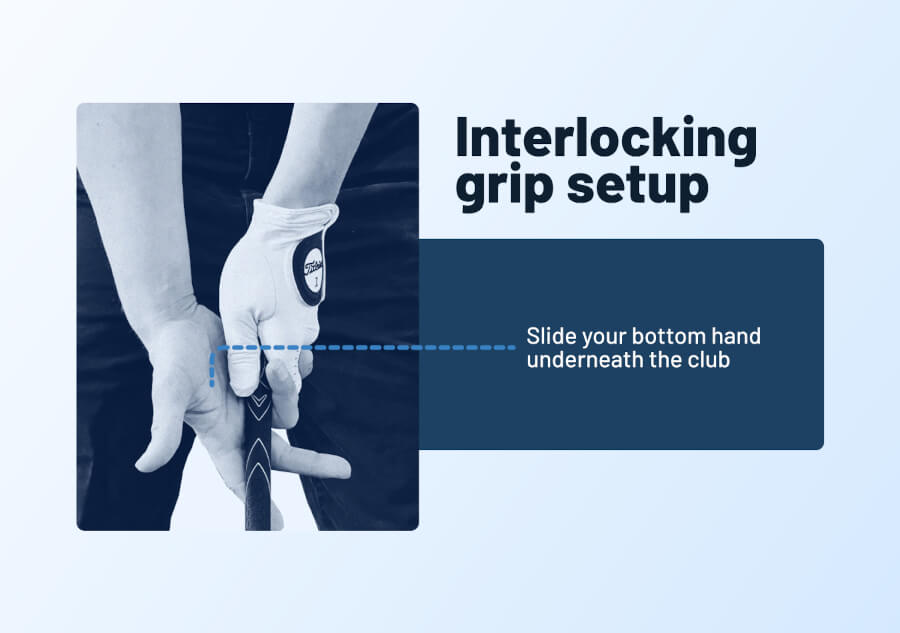
Pros
- Gives golfers a very firm connection with the club.
- Easy to get hands positioned even as a beginner.
- Beneficial for players seeking additional speed.
- Good choice for golfers with smaller hands.
Cons
- A firm connection can quickly lead to too much pressure in the grip.
- Feel around the greens may be a little more difficult to establish for some golfers.
10 Finger Golf Grip
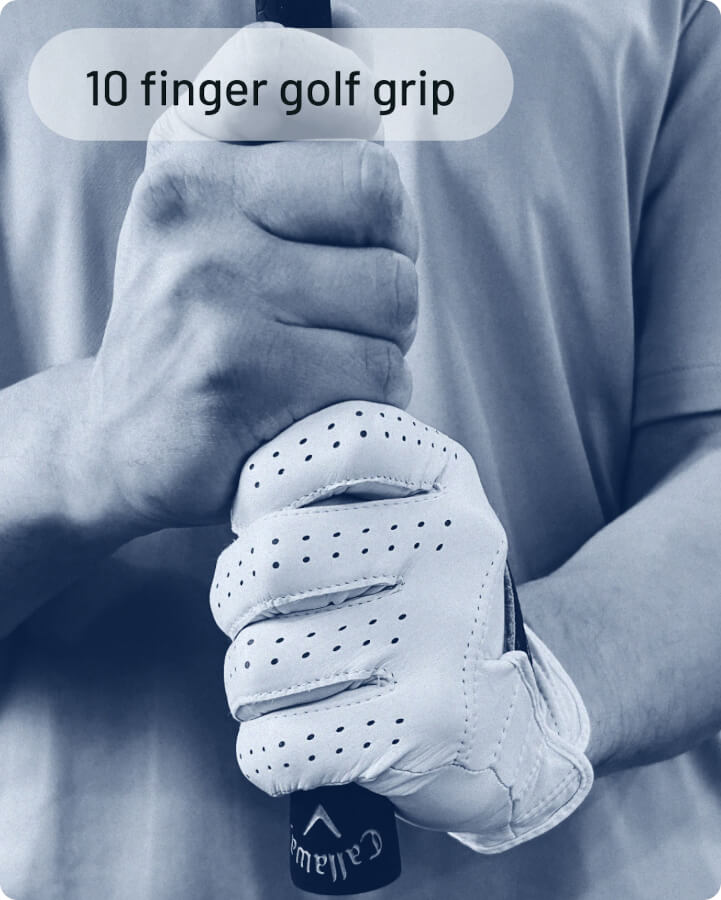
The 10 finger golf grip removes the concept of connecting the two hands on the golf club.
Instead, the left hand sits at the top of the club, and the right hand under it, with no overlapping or interlocking.
- Start with your left hand position; place the club across the base of your fingers so that when you wrap them around, the club sits mostly in the fingers and not in the palm of your hand.
- Next, make sure that your thumb is pointed just to the right of center on the club, have it point down the shaft, and do not wrap it around.
- Next, place your right hand directly underneath your left hand.
- The index finger on your left hand and pinky finger on your right will touch, but they are just sitting next to each other.
- Now close the right hand around the left so that the left thumb fits perfectly in the palm of the right hand.
I teach this grip to young kids when they first start playing because it can help with strength in the hands and increase the control they have over the club.
Many beginners start with this grip and then move to interlock or overlap as they develop more skills. My preference for beginners is to have them choose an interlock or overlap, as it can make a tremendous difference in the way a golfer swings the club.
The 10 finger grip serves its purpose, but the major problem is that golfers swing the left and right hand a little independently of each other. The results can be too much manipulation of the clubface angles in a way that is actually negatively impacting the player.
In addition, I’ve noticed many golfers with the 10 finger grip make more of an arms-based golf swing and lose some power that the legs and core can provide.
Again, some players can use a 10 finger grip and play quite well, but it’s best to be aware of these negatives.
Pros
- Very simple to learn.
- Can help younger golfers with small hands learn to hold the grip.
- Often taught to beginners who don’t have much experience.
- Can help with arthritis and golfers who have pain in their hands.
Cons
- The right hand tends to get a little too involved in the swing.
- Trouble with feel around the greens.
- Can cause issues with the takeaway.
Are These the Only Choices I Have?
Interlock, overlap, and 10-finger golf grips are the three choices that golfers have for the full swing. Of course, you could try and invent your own way to hold a golf club, but after a few hundred years, we have a pretty good handle on the fact that these are the most effective methods.
However, when you get to the putting green, things change. There are several types of putting grips to choose from.
Grip Strength Explained
Your grip could be neutral, weak or strong depending on how your hands are placed on the club (rotationally). The easiest way to think about this is while gripping a club and looking down at your hands.
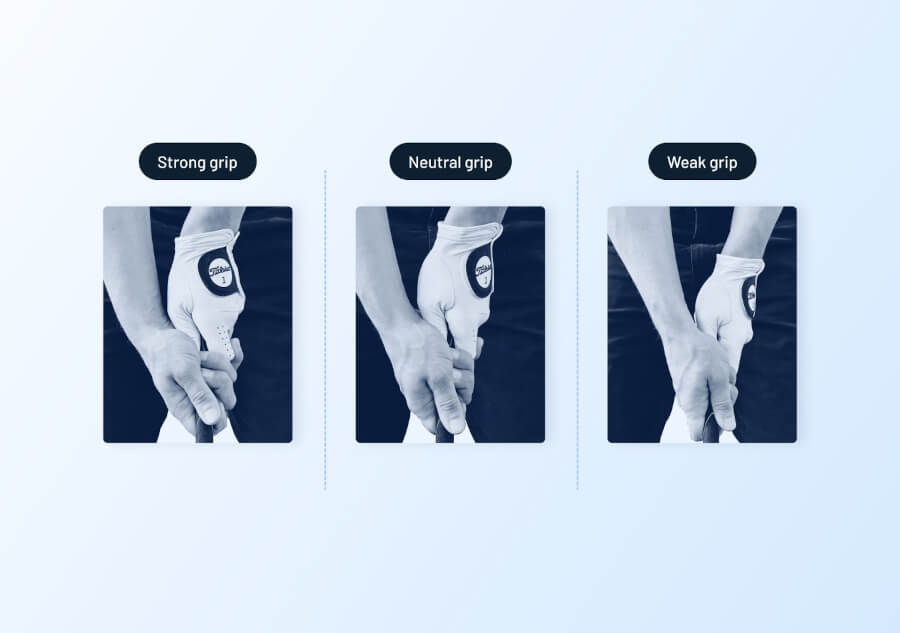
Neutral grip has your hands directly in front of you with the thumbs pointed mostly down the center of the shaft. The strong grip takes that entire position and twists it to your right (as you are looking down at the club); the weak grip turns everything to the left.
Weak Grip
A weak grip will have the right hand in a weaker position throughout the swing. The weak grip has nothing to do with grip pressure; it’s more about the position of the hands and their ability to work in your golf swing.
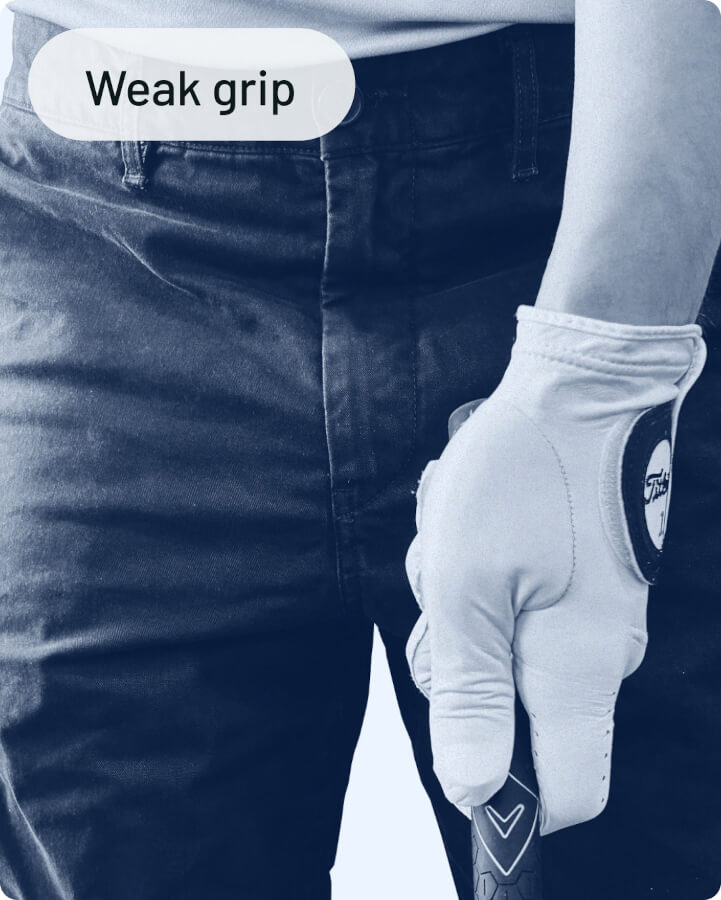
- Start by taking your left hand and putting it in a neutral position, with the club in the fingers as if you were going to take a neutral grip.
- Now turn your left hand a ¼ turn left (the amount of turn is up to you based on how weak you want the grip, but this will give you an idea).
- You will notice that you see fewer knuckles on your left hand and more on the top of your thumb pad.
- Put the right hand on the club in your preferred matter (i.e. interlock, overlap, 10 finger).
- With a weaker grip, you will see more of the knuckles on your right hand, as your right hand will be more on the top of the club.
The weak grip is great for golfers that hook the ball. Sometimes a hook is caused by that overactive right hand shutting the clubface through impact. If you can get the hands into a weaker position, it could square up the clubface.
Players who have a weak grip at address tend to have more flexion in their wrists. This flexion is a great thing to have at impact if a player can return the weak grip back in a flexed position.
Pros
- It can help to control a hook.
- Makes the left hand the lead in the swing.
Cons
- Some golfers will find that they can’t square the clubface at impact with a weak grip.
- The right arm can come too far over the top of the club and make it difficult to get the swing on plane.
Neutral Grip
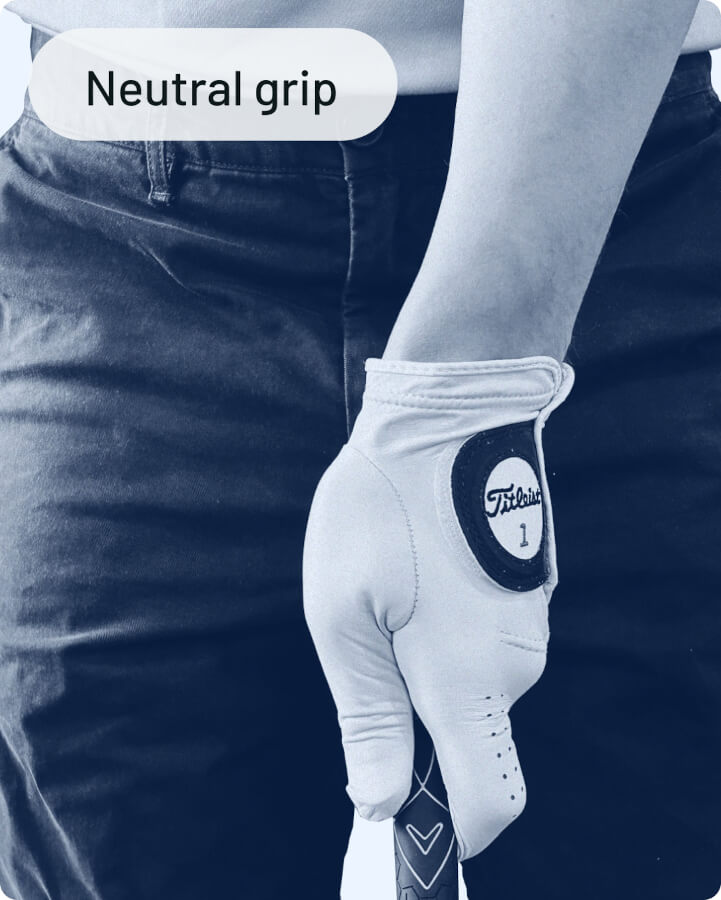
A neutral grip is how you should hold the club the majority of the time. Having a slightly strong or slightly weak grip is fine, but when you can base most of what you do around neutral, it will help with consistency in your golf game.
The neutral grip is exactly as described above, with your hands centered on the top of the club.

Strong Grip
A strong grip has the right hand in a more powerful position that can help golfers square the clubface at impact. If you are a golfer that slices the ball, this is a grip to consider using.
- Start by taking your left hand and putting it in a neutral position, with the club in the fingers as if you were going to take a neutral grip.
- Now turn your left hand a ¼ turn right (the amount of turn is up to you based on how weak you want the grip, but this will give you an idea).
- You will notice that you see more knuckles on your left hand and more of the top of your hand.
- Put the right hand on the club in your preferred matter (i.e. interlock, overlap, 10 finger)
- With a stronger grip, you will see more of the fingers on your right hand, as your right hand will be more on the bottom of the club.
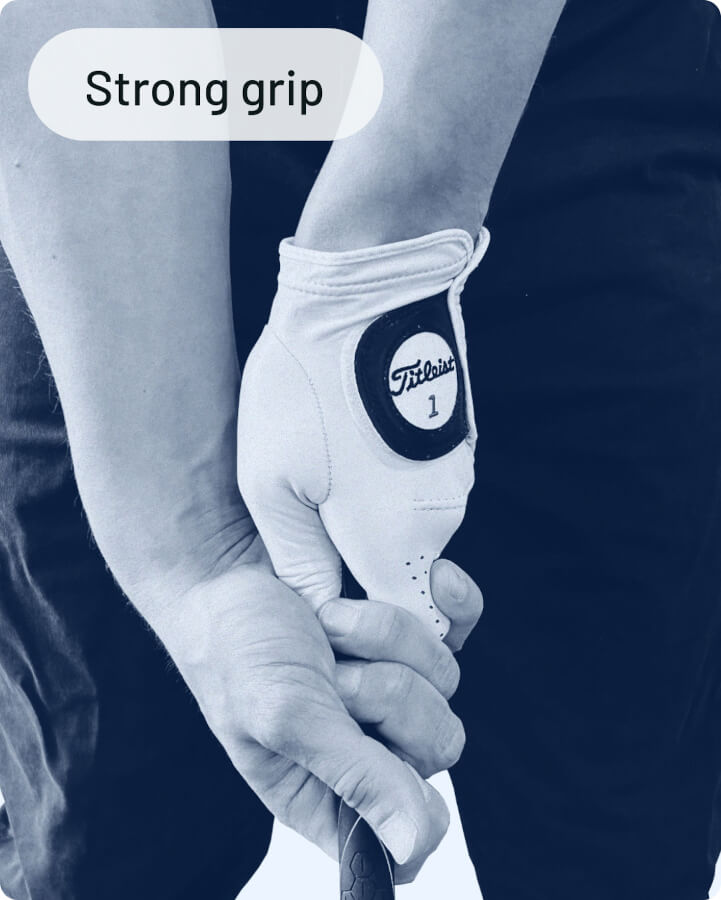
Pros
- Strong grips can help to eliminate a slice.
- Players with a weaker left hand can feel like it’s easier to close the clubface at impact.
- Makes it easier for players to understand how to release a golf club.
Cons
- It can get too strong and cause a hook.
- Often makes the right hand get too active in the swing.
Grip Pressure Explained
Now that you have an idea of how to hold the golf club in regard to connection and position, we have to talk about grip pressure.
Chances are you have heard the concept of holding the club like it’s a baby bird.
I don’t agree with this concept; I think grip pressure should be enough to have a firm connection on the club but not enough to create tension in your forearms.
How Much Pressure Should I Use to Hold a Golf Club?
Grip pressure needs to be strong enough that you have control over the golf club. I’ve seen players try to loosen their grip pressure and have a terrible time trying to control the angle of the face through impact.
When you grip a club too tightly, it can actually cause you to lose some distance. The tension in your hands and arms builds up and will restrict overall motion in your swing.
You have to find a grip pressure somewhere in between too tight (with tension) and too loose (with lack of control. I recommend doing this on the driving range hitting ten shots with a 7 iron and gradually decreasing grip pressure until you find the ideal amount.
What are Pressure Points?
Pressure points in your hand are where the majority of your grip pressure should be. This diagram gives you a good indication of where the pressure is, and it will change a bit throughout the swing.
Remember that there should be no pressure in the palms of the hands; that’s not where you want to focus any of your strength. The pressure points are in the fingers.
Proper Golf Grip: How Grip Affects My Shots?
Your hands connect with the golf club and set the foundation for the rest of your swing. The grip is incredibly important as it has a large impact on the clubface angle.
With the new ball flight laws in golf, we know that the clubface angle at impact is what determines the direction of the ball.
How to Know which One is for Me?
The best way to know how to hold a golf club is to experiment with the different types and see where you have the most success.
There are some general guidelines to follow, and they act as a good starting point. However, you should still test each type.
If I followed the guidelines, I would most certainly use an interlock, but I don’t play golf as well with an interlock grip.
- Small hands: interlock.
- Large hands: overlap.
- New player: 10 finger grip.
- Slicer: strong grip.
- Hook: weak grip.
- Arthritis and hand pain: overlap or 10 finger grip.
- Strong hands: overlap.
- Weak hands: interlock.
Which Grip is Better?
There is no perfect golf grip; the best grip is the one that works for your game. Looking at the grips of professional golfers can teach us a lot about what works, what doesn’t, and how you have to match the grip style you choose to your hand size and natural talents.
Why is Proper Grip Important?
What would you rather work on; your golf grip or driver distance?
Chances are your answer would be driver distance; the golf grip is a bit boring to work on.
However, what if I told you that the proper golf grip could impact your driving distance and your accuracy?
Makes the grip a bit more exciting, doesn’t it?
The golf grip lays the foundation, you don’t have to work on it, but until you do, you are wasting your time working on other fixes.
Does My Grip Make a Difference to the Club Face?
Your grip directly impacts the angle of the clubface at impact. If you want to hit the ball straight, you have to grip the club in a way that allows you to return the clubface to square at impact.
How does Grip Size Impact Grip Type? (What about Hand Size?)
The game of golf used to be for the average-sized person. Clubs were made to fit average people, grips were made to fit average people, and even golf courses (tee positions) were made to fit average people.
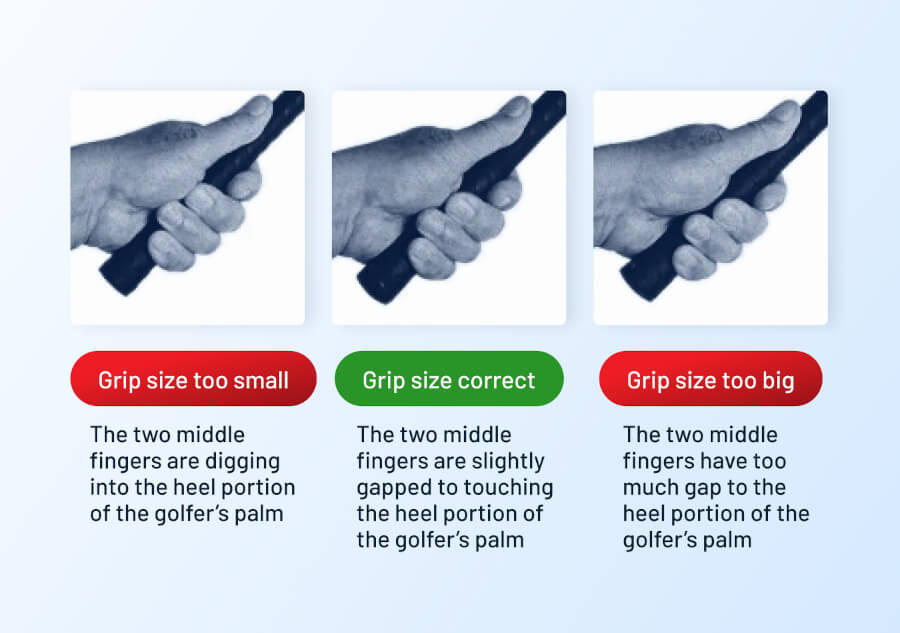
Luckily this has changed.
Your hand size and your grip size will play into the grip selection you choose and how to hold a golf grip.
Grip size is usually standard, midsize, jumbo, or undersize. Most of the time, you can choose your grip size based on your glove size. The standard is for a large size glove, undersized is for small and medium, and then it goes up from there.
However, you can also fine-tune the size of the grip using layers of tape to get the exact width you need.
When it comes to hand size, the smaller your hands, the harder it is to wrap them around the club. The larger your hands, the harder it is to keep the grip pressure and strength under control.
Many golfers with smaller hands will choose an interlocking grip because they feel it gives them more power. I have an overlapping grip even though I wear a ladies-size small glove. The overlap grip just feels most natural when it comes to developing feel.
However, I did get undersized golf grips on all my clubs to help compensate for the smaller hand size.
How Can I Test the Consistency of My Golf Grip?
If you find a grip position that allows you to deliver the clubface to impact in a square position, you will want to keep it as long as you can.
How can you do this?
Not all that easy, unfortunately. Consistency in golf is hard, but a tool like HackMotion can make all the difference. Although HackMotion is a wrist sensor, it has helped me to get my grip to a consistent position each time I swing.
When setting up with the HackMotion, I notice the amount of extension in my wrist, and it generally stays pretty consistent. Within a few degrees, I’m completely fine with the numbers.
However, if I set up and the numbers are well off, then I may have an issue with my grip getting too strong or too weak.
Use the HackMotion data to perfect your grip and develop something consistent.
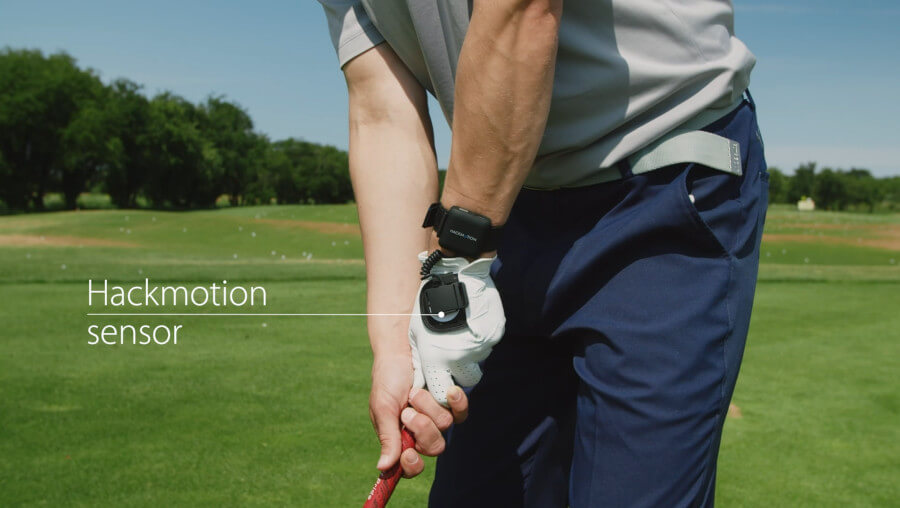
How Tour Players Grip
How do the best players in the world “really” grip the club? How do they use their hands to hit the ball so solidly? Is there really a “more important” hand to be able to perform a good swing?
We have in-depth research on the 150 players considered the most “significant” today, namely the first 120 male players in the world order of merit (March 2022) and the 30 strongest and most influential players of the last 70 years (both men and women).
To help make this information a bit easier to understand, we will break it down by lead and trail hand data and the address, top of the backswing and impact positions.
Lead Hand at Address
If you remember, our guide on how to hold a golf club explains that the neutral grip is the goal for most players.

This information was confirmed when looking at tour player data.
- 57% of players have a neutral 2-knuckles position.
- 31% of players have a weak 1-knuckle position.
- 2% of players have a strong 3-knuckles or more position
Using HackMotion sensor, these positions might look like, roughly, the following:
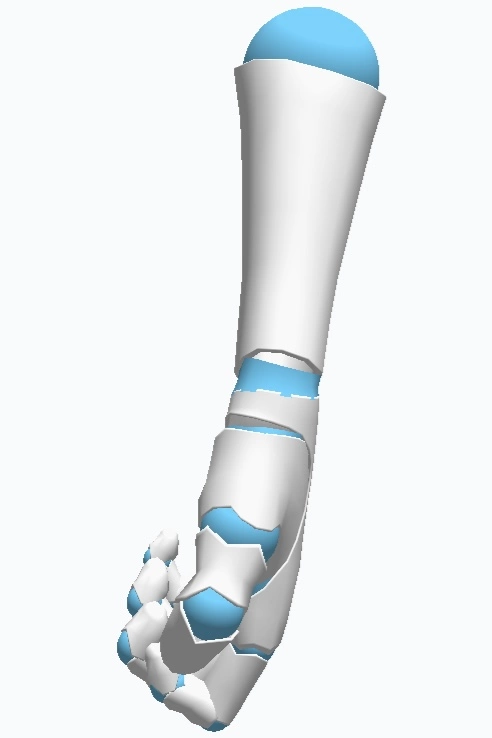
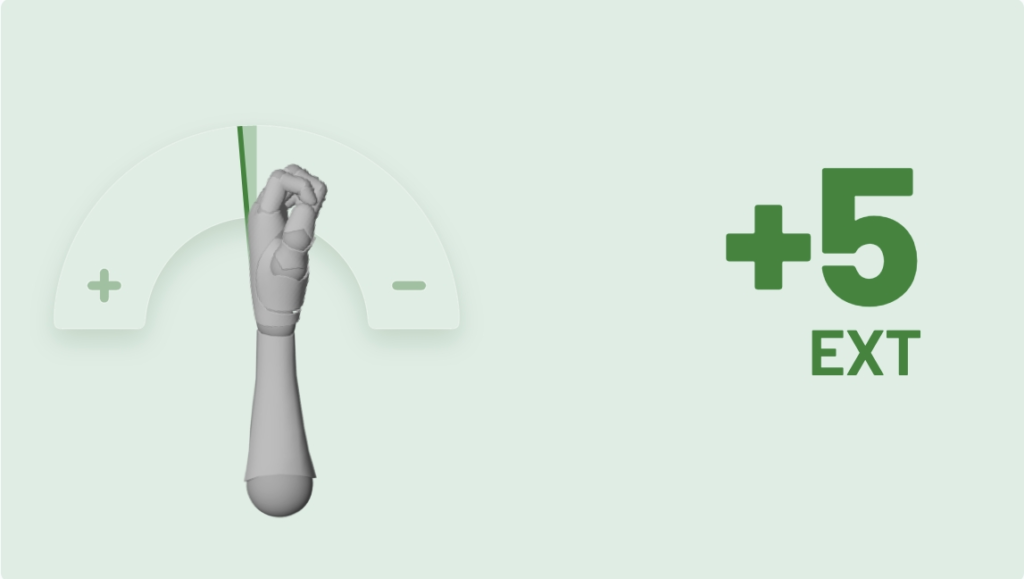
Weak position
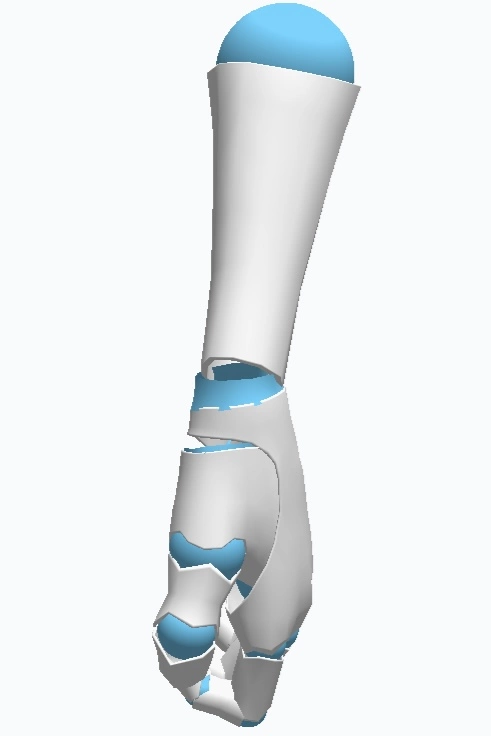
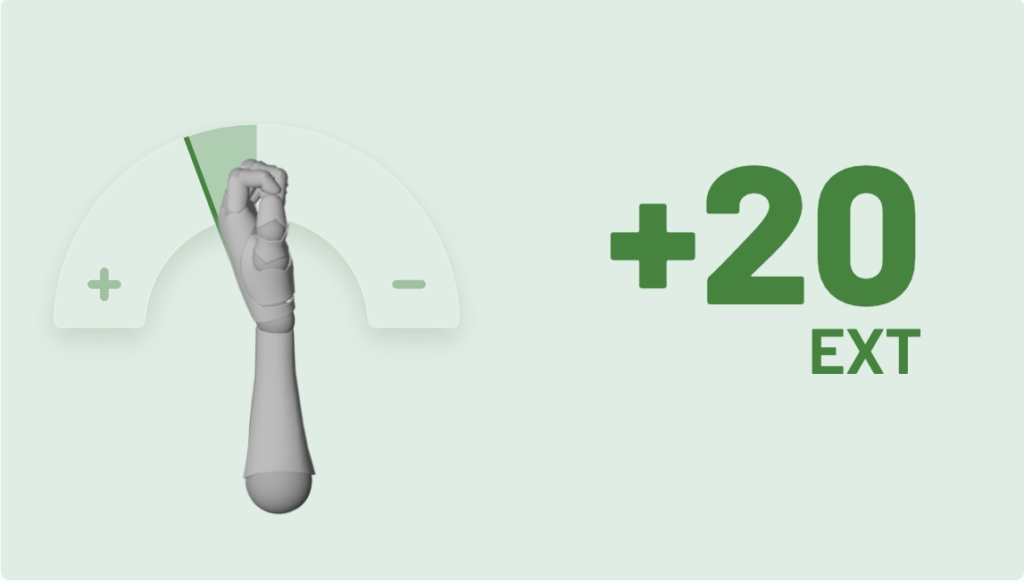
Neutral position

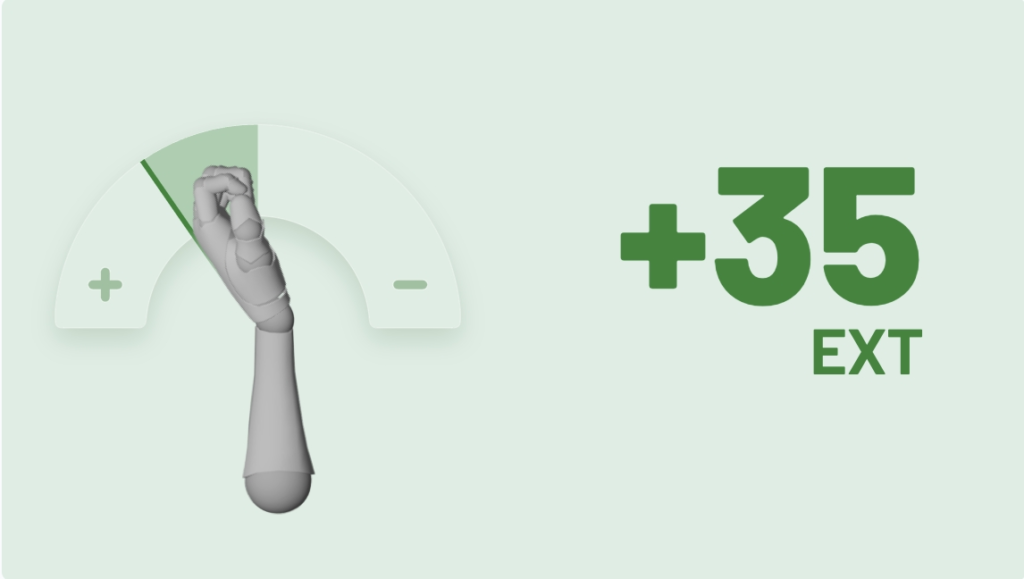
Strong position
Please note: the extension value measured by the sensor may vary with the position further back or forward of the hands at the address.
Lead Hand at the Top of Backswing
The majority of professional golfers have a flat wrist position at the top of their swing. With 57% of players able to get to this flat wrist position, it was important for us to know how they started their swing.
- 64% start with a neutral grip.
- 29% start with a weak grip.
- 7% start with a strong grip.

Nearly a quarter of all players in the study have an extended position at the top of their swing. Of the 24% of golfers that had an extended wrist position:
- 53% start with a neutral grip
- 29% start with a strong grip
- 18% start with a weak grip
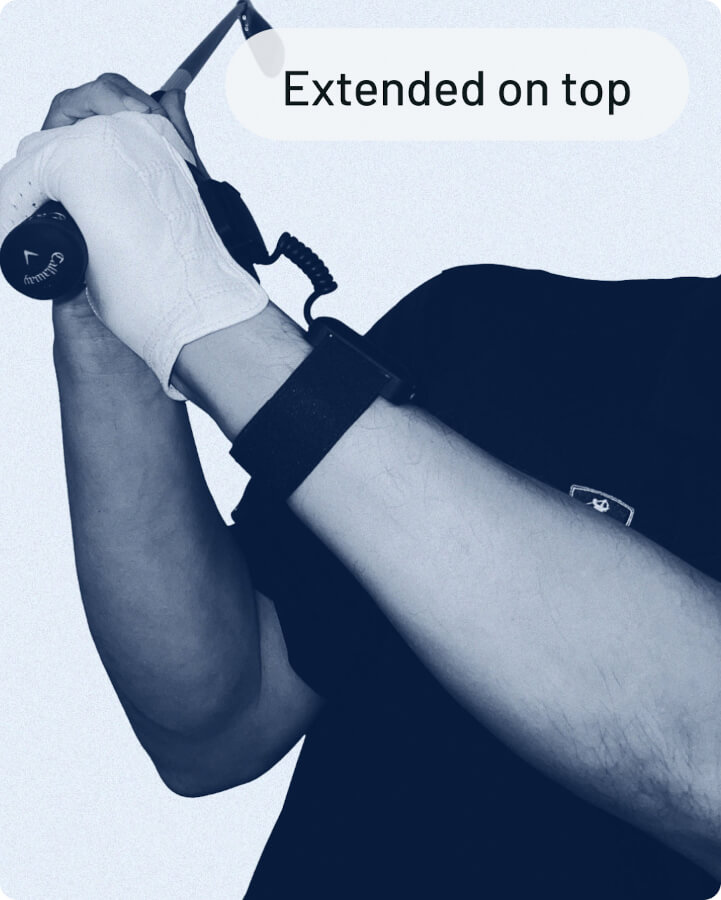
The smallest percentage of golfers have a flexed wrist position at the top of the backswing. If you have ever attempted this you likely can understand it takes quite a bit of flexibility to get to this position. Of the 19% that had a flexed position at the top:
- 52% start with a weak grip
- 42% start with a neutral grip
- 6% start with a strong grip
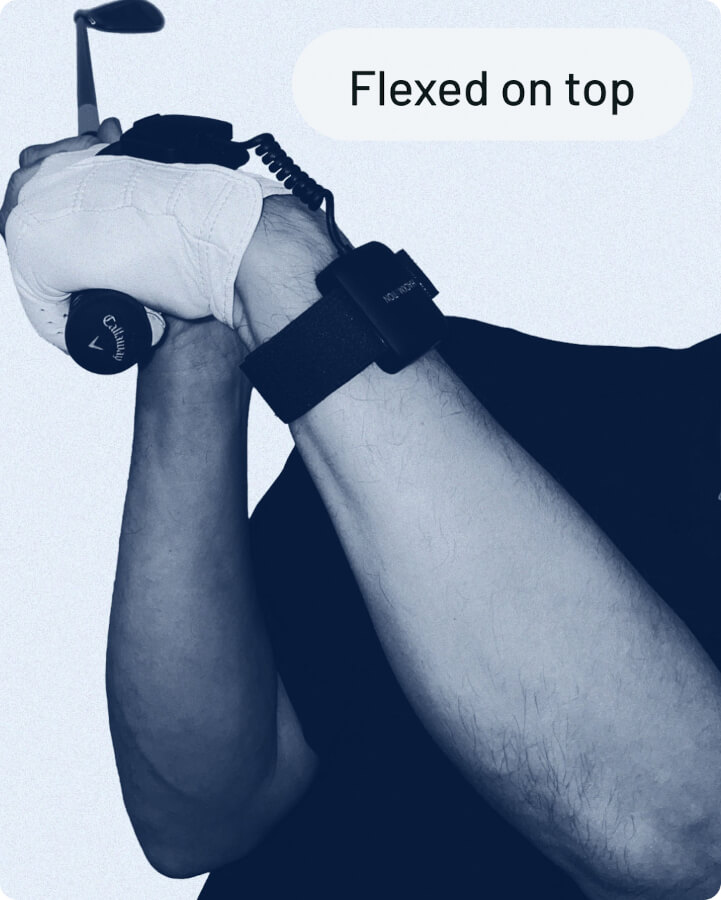
Using HackMotion sensor, these positions might look like, roughly, the following:
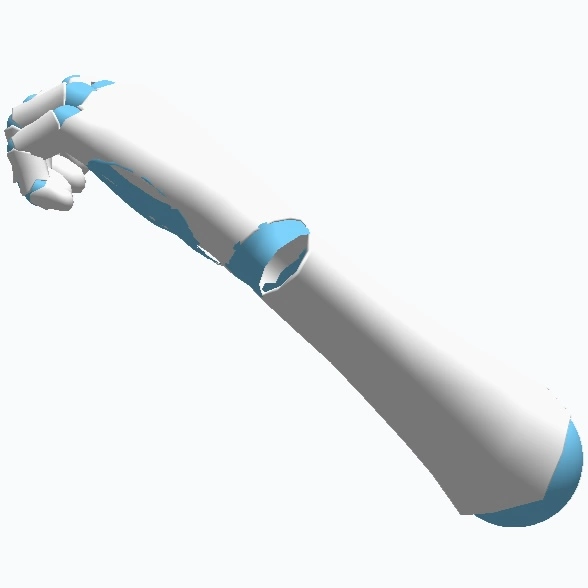

Flat wrist

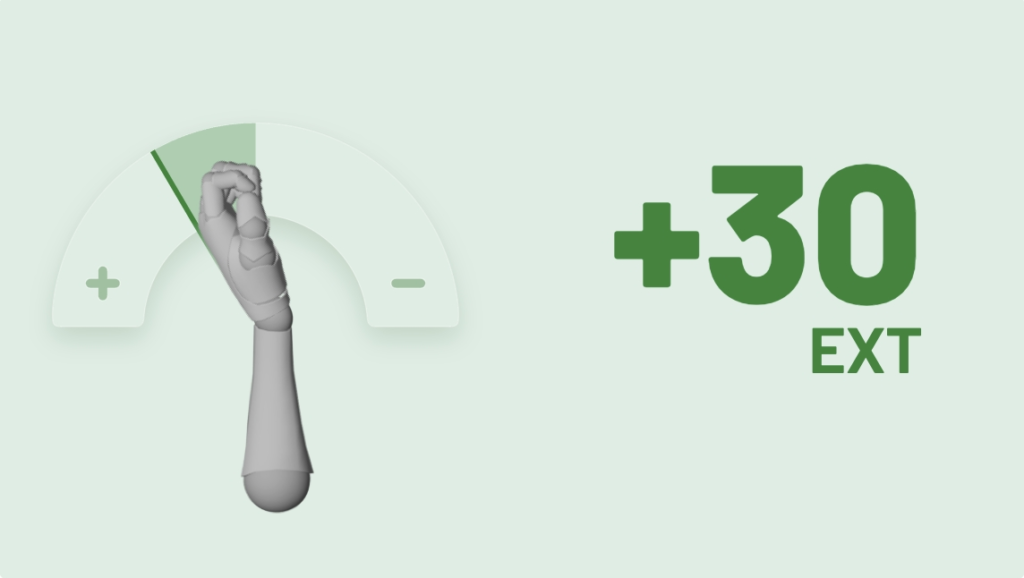
Extended wrist
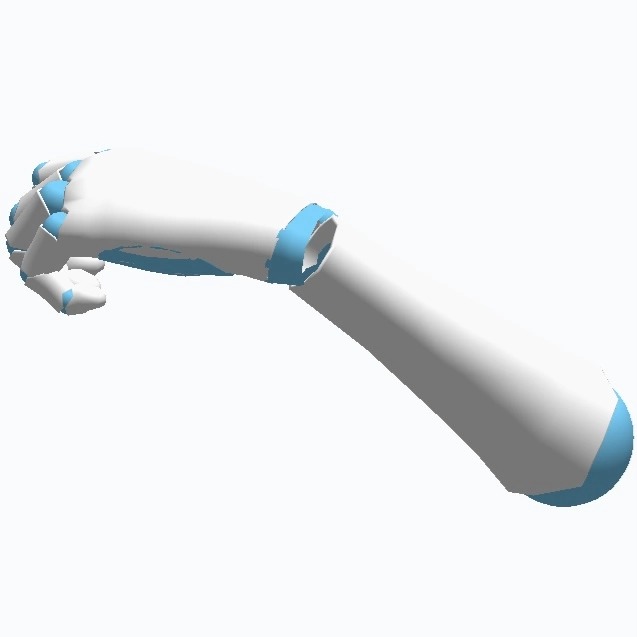
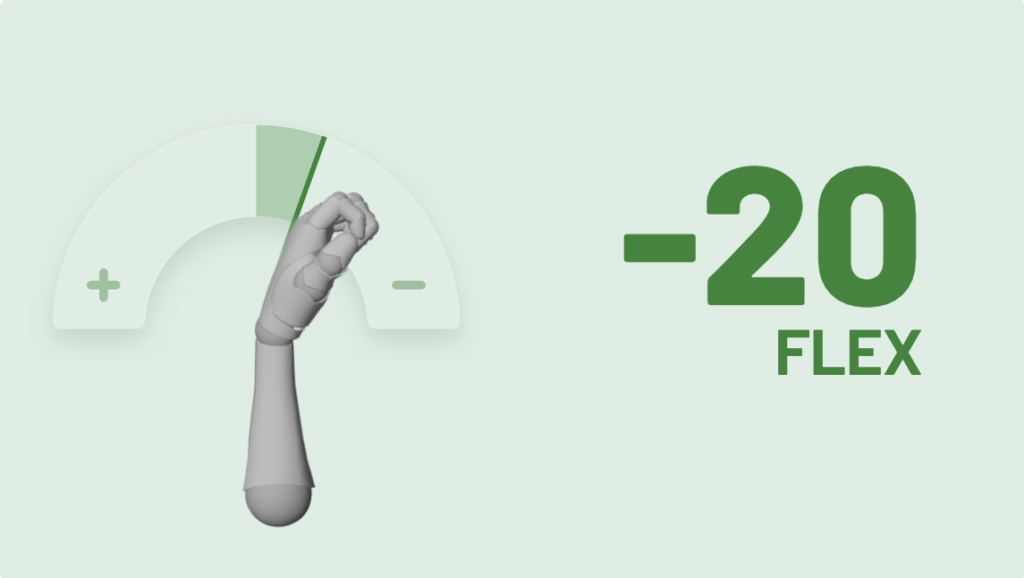
Flexed wrist
What do We Learn?
A weak grip can help lead to a more flexed position at the top of the swing, in addition neutral grips seem to be the best starting position to ensure a flat lead wrist, or a slightly extended wrist.
Lead Hand – Address vs Top of Backswing
Now that we have information on the top of the swing and the address we can see what address positions lead to the top of the backswing positions.
Of the players with a weak 1-knuckle lead hand:
- 54% have a flat wrist at the top.
- 32% have a flexed wrist at the top.
- 14% have an extended wrist at the top.
Of the players with a neutral 2-knuckles lead hand:
- 64% have a flat wrist at the top.
- 22% have an extended wrist at the top.
- 14% have a flexed wrist at the top.
Of the players with a strong 3-knuckles or more lead hand:
- 58% have an extended wrist at the top.
- 32% have a flat wrist at the top.
- 10% have a flexed wrist at the top.
What do We Learn?
The weak and neutral lead hand grips lead to a greater percentage of having a flat wrist at the top of the golf swing. In addition, there is a strong correlation between a strong grip and an extended wrist at the top of the swing.
Lead Hand – Impact
Although address and the top of the swing are incredibly important to learn about, the lead hand at impact is what matters the most.
The general tendency of players with weak grip is to present a flexed wrist and greater supination of the forearm at impact.
The general tendency for players with a neutral grip is to have a flat wrist at impact.
The general tendency of players with a strong grip is to have a flat or slightly extended wrist at impact and a “locked” position in pronation of the forearm.
Using HackMotion sensor, these positions might look like, roughly, the following:
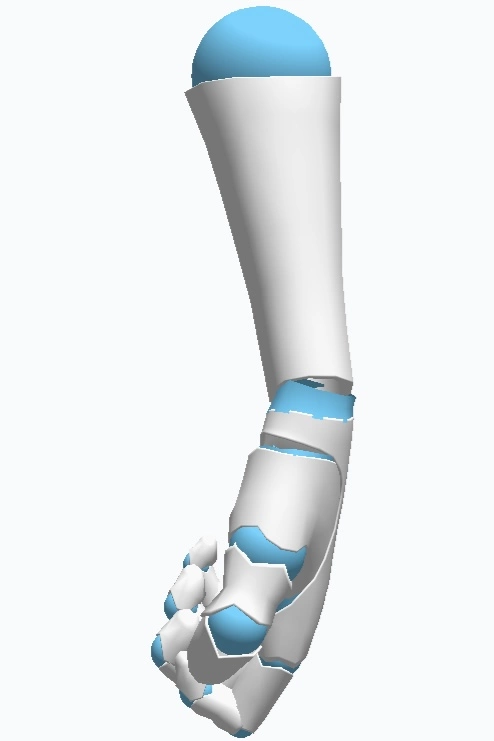
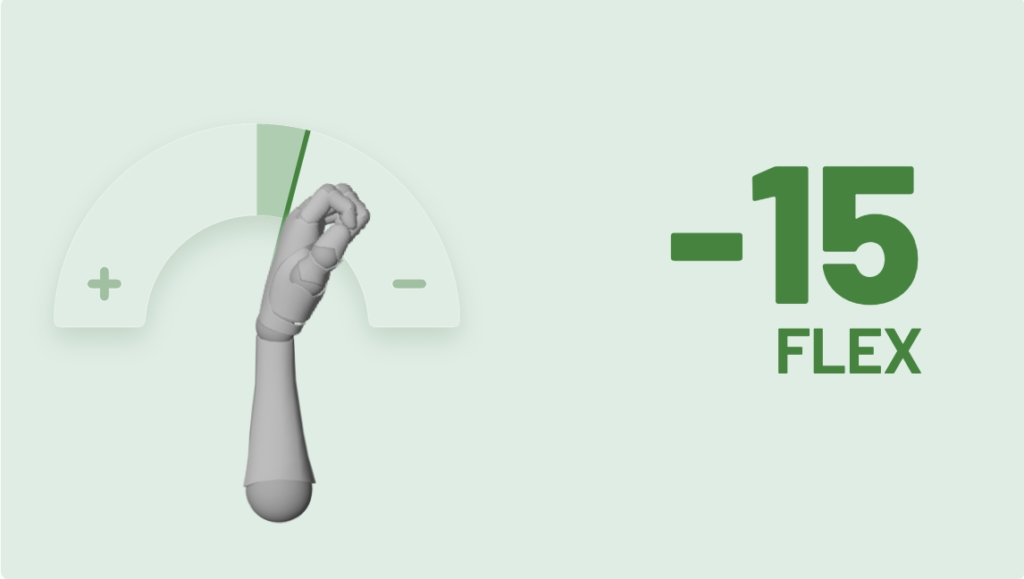
Flexed wrist


Flat wrist

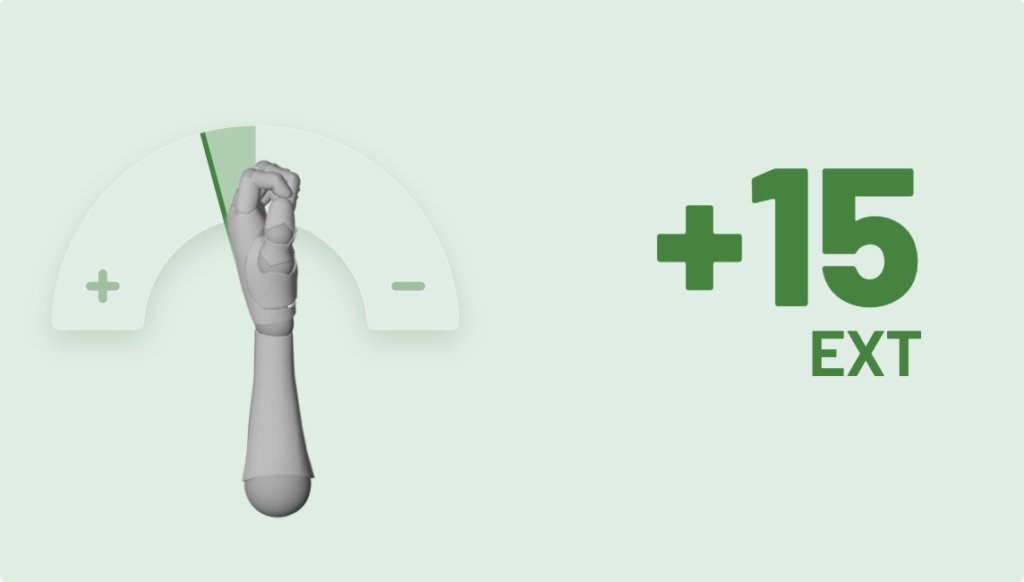
Extended wrist
Trail Hand – Address
The majority of data collection and analysis that we do is with the lead hand, but it’s important to at least look at the trail hand and the role it plays.
With the trail hand, there are a few absolutes among all players on the list that really stood out.
- No player has a very weak position with the palm closed to the clubface and facing downward and the “V” formed by the thumb and index finger clearly pointing the lead shoulder.
- No player has a very strong position with the palm open to the clubface and facing upward and the “V” formed by the thumb and index finger pointing away from the trail shoulder.
- Regardless of the position of the high hand or “lead”, 95% of the players have a perfectly neutral position with the palm parallel to the club face and facing the target and the “V” formed by the thumb and index finger pointing, indicatively, towards the trail cheek.
- 4% of the players have a neutral position trending too strong with the palm parallel enough to the club face and the “V” formed by the thumb and index finger pointing towards the trail shoulder.
- 1% of the players have a neutral position trending too weak with the palm parallel enough to the club face and the “V” formed by the thumb and index finger pointing towards the center of the body. This “more covered” position is typical of players with a stronger lead hand with 3 or more knuckles.
Trail Hand – Impact
The trail hand at impact is extended for all players in our study, this is a position that golfers must get to in order to produce the results they are looking for at impact.
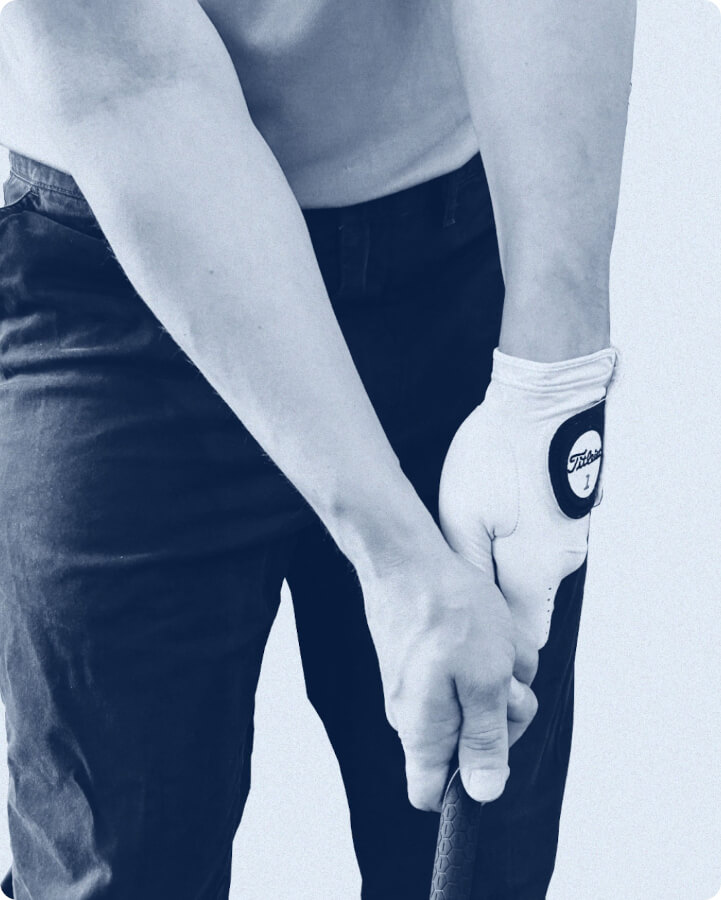
Final Thoughts on Tour Player Grip Data
This study is not perfect as it does use 2D data to get the results. Having all tour players wear the HackMotion and gain data would give us much more insight.
However, with the information collected, we were still able to make the following conclusions.
- It is possible to play high-level golf with different lead hand positions (very weak, weak, neutral, strong, and very strong), the trail hand position cannot experience as much variation.
- The most important position to respect to obtain optimal control of the clubface is a neutral trail hand with the palm parallel to the clubface.
- From a biomechanical point of view, it is possible to live with a strong trail hand facing upward, while it is very difficult to obtain good impacts with a particularly weak trail hand with a palm facing downward.
- A neutral lead hand combined with a flat wrist at top of the backswing represents the most popular choice among the best players, as it allows easier control of the clubface and dynamic loft to obtain any type of ball trajectory with more versatility.
- A weak lead hand can be an excellent choice for many players, as it allows wrist flexion, thus moving the center of mass of the club behind the hands and favoring both the flattening of the swing plane in the downswing and the club lag.
- A strong lead hand can be a good choice for anyone looking for a very straight shot or a gentle fade, as it helps to “block” the clubface from closing through impact. However, it is not particularly popular with top players as it can reduce versatility and the ability to reproduce all types of ball trajectories.
Although they represent the minority, the presence among the best in the world of players with strong grip combined with a flexed lead wrist at the top and of players with weak grip combined with an extended lead wrist at the top reminds us how much the dynamics of a good swing, regardless of general trends, is always the result of individual and personal choices and must be taken into consideration.
FAQs
Here are a few of the most commonly asked questions about how to hold a golf club.
What is a shortened left thumb?
The thumb of the lead hand is often pushed up a bit as opposed to fully extended on the club. With a shortened left thumb, there is more strength in that connection point on the club and some players find a better fit in the palm of the right hand.
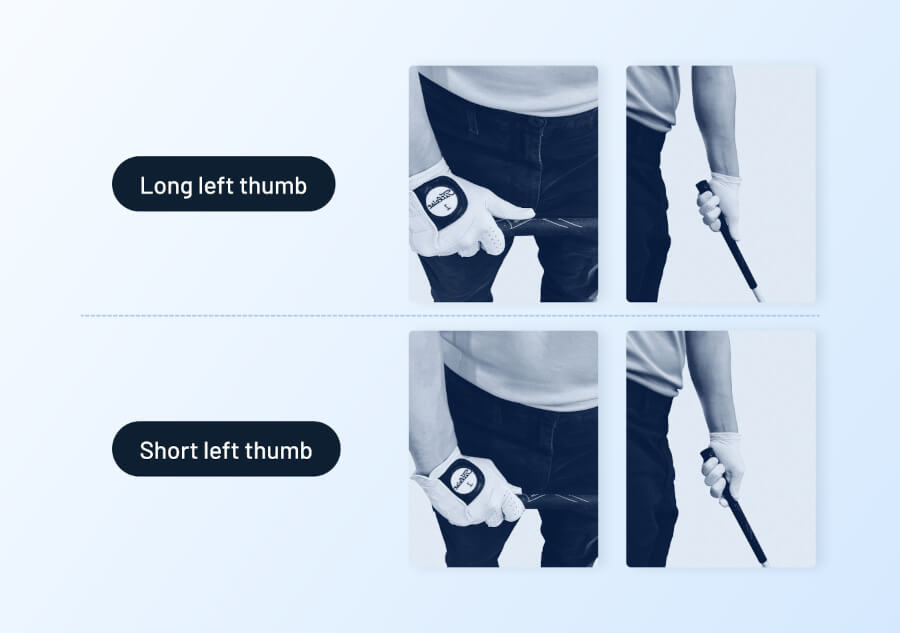
Should I use the same grip for my irons and driver?
Keeping a consistent grip is a good decision for most golfers; when trying to hit a fade or a draw with certain clubs, you can change the grip position and have the clubface return to impact at a different angle.
How to change your grip?
Changing your grip takes some time spent on the driving range. In addition, using a tool like HackMotion can help with a grip change, as it will improve your awareness of the hand and club position.
Is a putting grip different?
The most common putting grip is a reverse overlap. However, there are other putting grip options, including the claw, cross-handed, and more.
Is the grip the same for left and right-Handers?
Golf grip is simply reversed for left and right handed golfers. The lead hand for the right handed golfer is the left hand, for the left-handedd golfe,r it’s the right hand.
Final Thoughts
Now that you have the ultimate guide on how to hold a golf club, it’s time to get out there and start working on your grip.
HackMotion can give you so much insight and data into why your hands do what they do and help you perfect the positions you need in your swing. With HackMotion, you can truly see how holding the golf club can produce different results on the course.





